SMA to BNC Adapter: Selection & Ordering Guide
Sep 30,2025
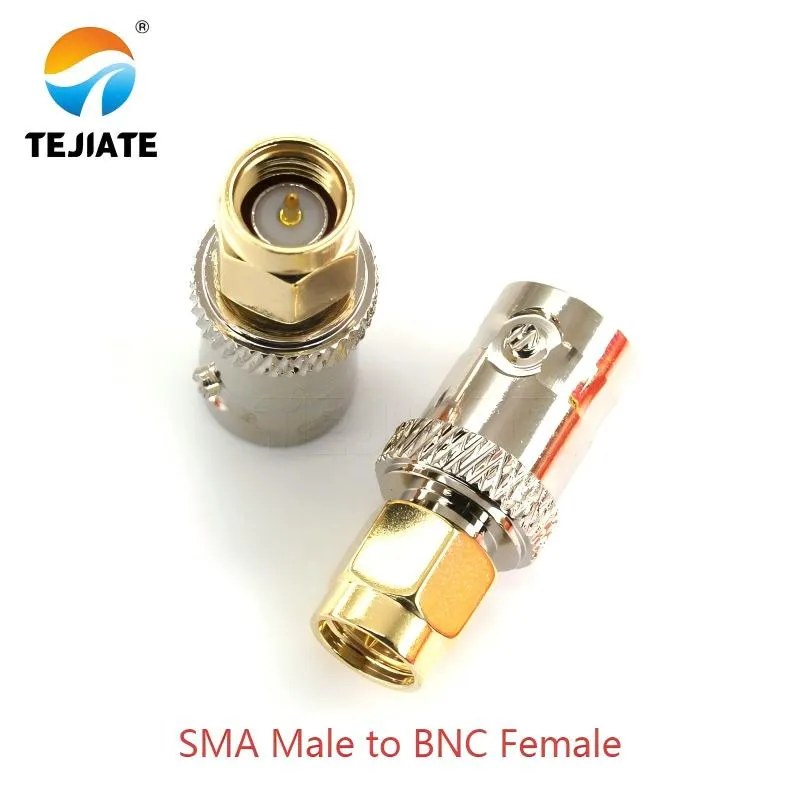
serving as the opening graphic. It shows a physical example of a typical SMA to BNC adapter from TEJIATE, used to connect devices with SMA ports (e.g., handheld radios) to instruments with BNC ports (e.g., oscilloscopes). The document emphasizes that selecting the right adapter is crucial for ensuring signal integrity, low loss (e.g., ≤0.15 dB @ 6 GHz), and low VSWR (typically below 1.2).
When you’re working with RF systems, it’s surprising how often a small part decides the success of the whole setup. An adapter may look trivial, yet the wrong one can throw your measurements off, add unwanted reflections, or simply refuse to connect. At first glance, an SMA port and a BNC port don’t seem that different, but mixing them up leads to frustration. That’s why choosing the right SMA to BNC adapter matters.
This guide walks through the main checkpoints step by step. It blends practical lessons from real deployments with solid specifications. For instance, TEJIATE’s SMA series use PTFE dielectric, gold-plated brass or stainless-steel contacts, and are rated for 0–18 GHz operation. Specs like these mean the parts aren’t just placeholders — they’re designed to deliver stable performance over time.
How do I confirm I need SMA to BNC and not another path?
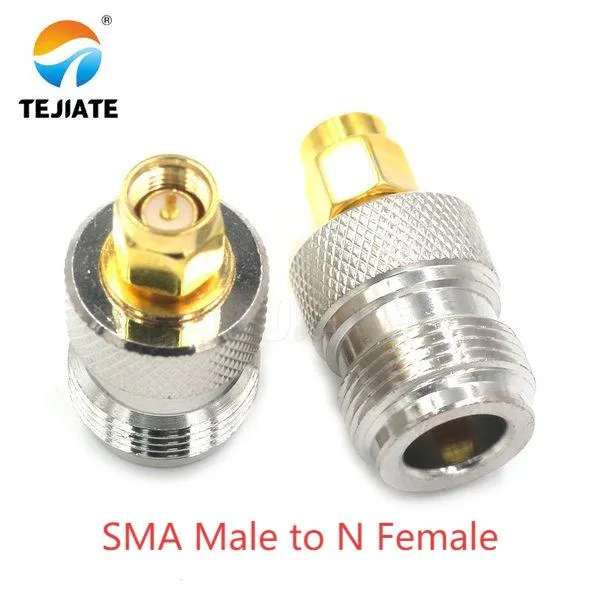
appearing during the discussion of "When SMA to N or SMA to TNC is smarter". The document states that for outdoor antennas, higher power, or applications requiring better weatherproofing (IP67), an SMA to N adapter is a better choice than BNC. This image shows the physical adapter for this alternative path.
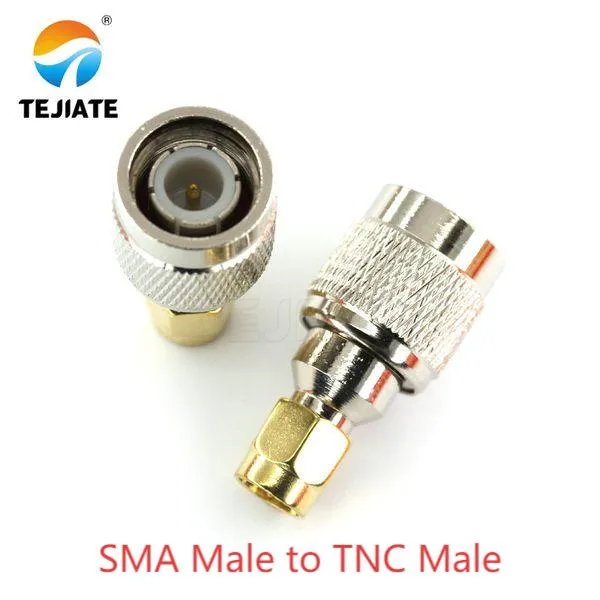
also appearing during the discussion of alternative adapter choices. The document explains that in environments with constant vibration (e.g., vehicles, base stations, industrial cabinets), SMA to TNC adapters are the best choice due to their more secure connection. This image shows this adapter suitable for vibrating environments.
SMA (incl. RP-SMA) vs BNC, gender/polarity
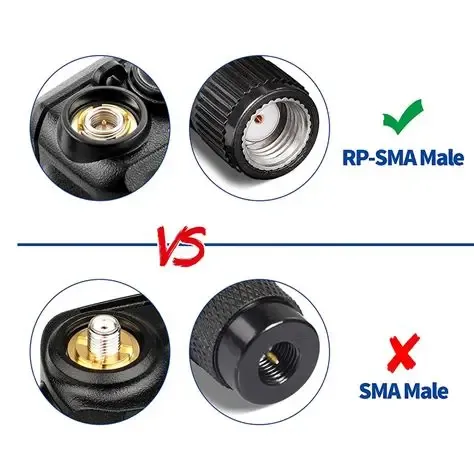
used while explaining "SMA (inc1. RP-SMA) vs BNC, gender/polarity". It clearly shows, through physical comparison, the fundamental difference in the center contacts between an RP-SMA Male (no pin, socket instead) and a standard SMA Male (with a pin). The document emphasizes that this is a common point of confusion in Wi-Fi gear and polarity must be checked during selection.
SMA connectors rely on a 1/4–36 threaded coupling, and the center contact determines gender. A male SMA shows a protruding pin, while the female has a receptacle. In RP-SMA (reverse polarity), this rule flips — the outer shell looks the same, but the center conductor is reversed. That’s why so many Wi-Fi setups cause confusion; the connector looks familiar until you realize the pin is missing.
BNC connectors are easier to spot thanks to their bayonet twist-lock. A male BNC has a rotating collar with a central pin, while the female features slots and a receptacle. If you’ve ever worked in a hurry, you’ll know how tempting it is to assume “bayonet = BNC.” I’ve seen technicians on CCTV projects waste hours chasing “faulty cables,” only to discover they tried to mate an SMA jumper with the wrong bayonet port.
TEJIATE’s SMA line is available in both standard and RP-SMA types, all tested with insertion loss ≤0.15 dB at 6 GHz and VSWR typically below 1.2. That level of performance comfortably supports 2.4 GHz Wi-Fi, 5.8 GHz networking, and LTE bands, making them versatile for both test benches and deployed systems.
When SMA to N or SMA to TNC is smarter
It’s easy to default to an SMA to BNC adapter, but sometimes another path is simply better.
- SMA to BNC: Perfect when connecting handheld radios, IoT boards, or CCTV gear to lab instruments.
- SMA to N: The go-to choice outdoors, especially when power handling and IP67 sealing are priorities.
- SMA to TNC: Best for installations where vibration is constant — in vehicles, base stations, or industrial cabinets.
Think of them as three siblings: BNC for the lab, N for the weather, and TNC for the shake. Each shines in its own environment. If you’re unsure which family fits your case, the RF coaxial cable guide gives a side-by-side breakdown of connector roles and use cases.
Personal tip: In one field deployment, switching from SMA to BNC to SMA to N solved persistent signal dropouts in a rooftop setup. The difference wasn’t the frequency — it was the weatherproofing. That’s the kind of nuance that specs on paper sometimes hide.
Should I pick straight or right-angle for my layout?
Pros/cons on handhelds, panels, racks
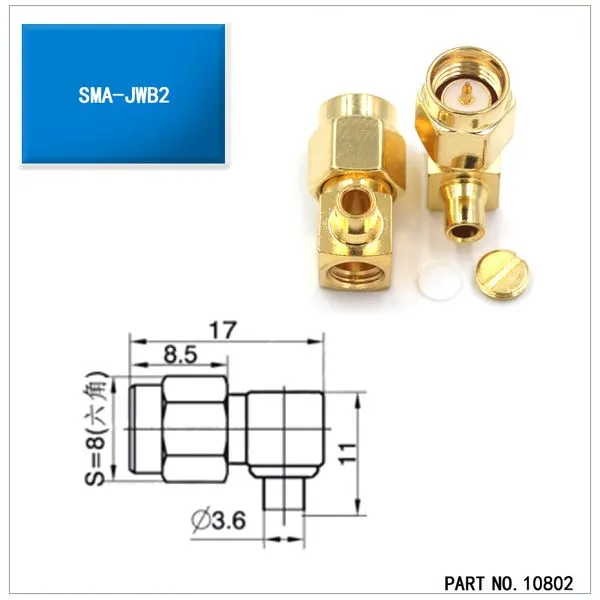
serving as a specific example of a right-angle adapter during the discussion of "Should I pick straight or right-angle for my layout?". It provides key mechanical dimensions (e.g., total length 17mm, hex S=8mm) and the part number (PART NO. 10802) for the SMA-JWB2 model, aiding users in precise installation planning for space-constrained layouts.
- Straight adapters: These keep things simple. The alignment is direct, and the added loss is minimal — often 0.1 to 0.15 dB at 6 GHz. For bench testing or lab instruments with plenty of clearance, they’re usually the cleanest choice.
- Right-angle adapters: These come into play when space is tight. A handheld transceiver with a top-mounted SMA port, for example, feels more comfortable if the antenna points sideways rather than sticking up. In rack panels, a right-angle version can prevent cables from jutting out and colliding with nearby equipment.
I’ve seen teams lose days of field testing because a radio’s SMA connector cracked under strain. A simple sma right angle adapter could have prevented that. Sometimes spending a few extra dollars saves hundreds in replacement costs.
Strain and reliability considerations
Metal couplers are rigid, and once tension is applied, they act like a lever against the connector port. That’s fine in a stationary lab, but in mobile or field setups it’s asking for trouble.
One workaround is to combine the adapter with a short SMA extension cable such as RG316 jumpers. A 20 cm flexible jumper absorbs the pull and reduces leverage, while the adapter still provides the necessary SMA-to-BNC conversion. This approach is particularly common in handheld radio fleets, where cables get bumped and twisted daily.
Which gender combo guarantees plug-and-play?
Among all the ordering mistakes I’ve seen, gender mismatch tops the list. The confusion usually comes from assuming the outer shell defines gender. In RF connectors, it’s the center contact that decides: pin = male, receptacle = female. Forget that rule, and you’ll end up with adapters that simply won’t connect.
Some engineers even keep a small “gender reference card” in their toolkits. It sounds excessive, but in high-volume procurement or field work, it prevents costly mix-ups.
Connection Matrix — Device port to Required adapter SKU to Need for M-F adapter/jumper
| Device Port | Target Port | Correct Adapter | Jumper Needed? |
|---|---|---|---|
| SMA-Male | BNC-Female | SMA-M to BNC-F | No |
| SMA-Female | BNC-Male | SMA-F to BNC-M | No |
| RP-SMA-Male | BNC-Female | RP-SMA-M to BNC-F | Sometimes (via SMA M-F) |
| BNC-Male | SMA-Male | SMA-M to BNC-M | Safer with jumper |
| SMA-Female | BNC-Female | SMA-F to BNC-F | Often via coupler |
Adapters in TEJIATE’s catalog use gold-plated brass or stainless steel housings and are rated for ≥500 mating cycles. That durability makes them reliable even when they’re part of a frequently reconfigured test bench.
If you’re unsure, pairing the adapter with a short sma male to female adapter or a sma extension cable is often the safer route. This small step avoids misaligned ports and saves frustration during installation.
Avoid RP-SMA mix-ups on Wi-Fi gear
Wi-Fi equipment is a common trap. Many routers and access points use RP-SMA Female — it looks like an SMA Female, but the center contact is reversed. I’ve seen buyers order boxes of standard SMA to BNC adapters only to find none of them fit.
For more background, the SMA connector basics guide shows side-by-side visuals of SMA vs RP-SMA, which is especially handy for first-time buyers.
How do I match 50 Ω/75 Ω and what happens if I don’t?
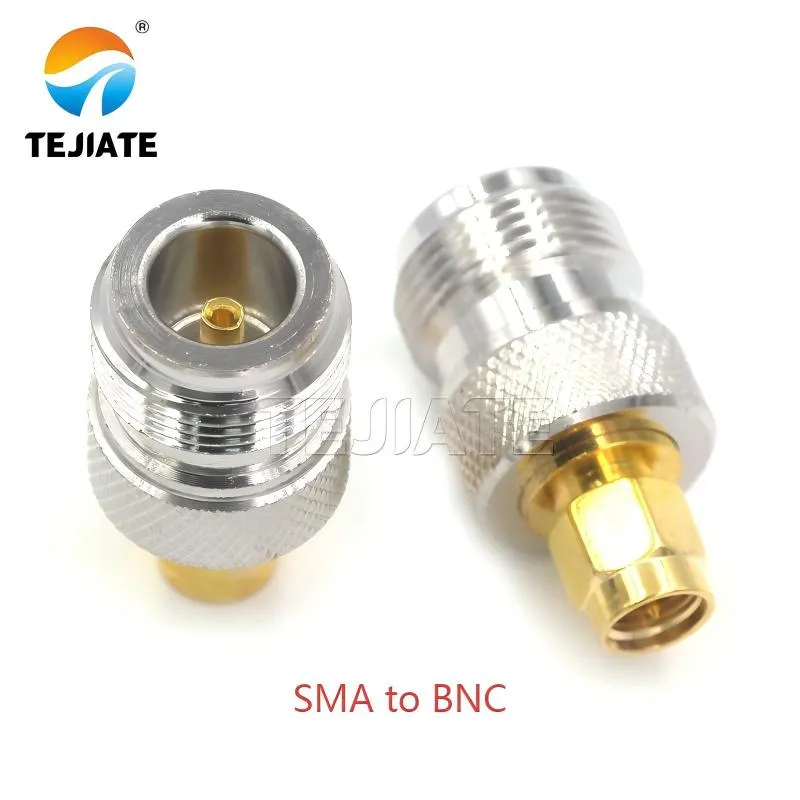
serving as a visual aid during the discussion of impedance matching (50Ω vs 75Ω). It generically shows the form of an SMA to BNC adapter, leading into the detailed discussion about correctly matching impedance (50Ω to 50Ω is ideal) and the potential performance degradation (e.g., increased return loss, reduced gain) if mismatched
In RF design, impedance is the invisible handshake that keeps everything working smoothly. Most SMA connectors and their cables are standardized at 50 ohms, while BNC connectors are sold in both 50 Ω and 75 Ω versions. Knowing which type you’re plugging into is essential.
- 50 Ω SMA to 50 Ω BNC to the ideal pairing, minimal reflections.
- 50 Ω SMA to 75 Ω BNC to technically works, but creates mismatch. This often happens when lab gear is connected to CCTV equipment.
- 75 Ω BNC to optimized for video signals; if paired with a 50 Ω line, expect some visible degradation.
From lab experience, mismatched connections don’t usually damage gear. But performance will drop — return loss increases, gain falls off, and in analog video systems ghosting often appears. For precision test setups, matching impedance isn’t optional; it’s mandatory.
For a broader overview of impedance roles in coaxial systems, check the RF coaxial cable guide. It explains why 50 Ω dominates RF while 75 Ω remains standard in broadcast video.
Symptoms of mismatch: return loss, noise
When a 50 ohm SMA cable meets a 75 Ω BNC input, the effects show up quickly:
- Higher VSWR to more power bouncing back, less making it through.
- Signal reflections to visible on spectrum analyzers as spurious peaks.
- Ghosting or noise to common in CCTV video feeds where picture quality matters.
In quick bench tests, this mismatch may be tolerable. But for long-term deployments, the right SMA to BNC adapter rated for the correct impedance saves hours of troubleshooting.
Field note: I’ve seen CCTV installers replace entire camera chains, only to discover the real culprit was a 50 Ω to 75 Ω mismatch at a single adapter. Always check impedance markings on both sides before signing off the install.
What insertion loss/VSWR should I expect at my band?
Every SMA to BNC adapter adds a little loss — usually so small that beginners shrug it off. But stack a few together and the impact grows quickly. Typical insertion loss per adapter sits between 0.1–0.2 dB, depending on frequency. That may sound trivial, but in sensitive RF systems even fractions of a decibel add up.
Think about Wi-Fi links at 2.4 or 5.8 GHz. If you chain three couplers, you could lose over half a decibel. That’s enough to lower throughput or shift test results. It’s why seasoned engineers calculate insertion loss the same way others calculate travel time — better to plan than to guess.
Cascade Estimator — Total_IL ≈ n×IL; band heuristics at 900/2.4/5.8 GHz
| Frequency | Typical Single Adapter IL (dB) | Max Cascade (n) | Total IL Limit (dB) | VSWR Range |
|---|---|---|---|---|
| 900 MHz | 0.1 | 6 | 0.6 | 1.05-1.10 |
| 2.4 GHz | 0.15 | 4 | 0.6 | 1.10-1.20 |
| 5.8 GHz | 0.2 | 3 | 0.6 | 1.15-1.25 |
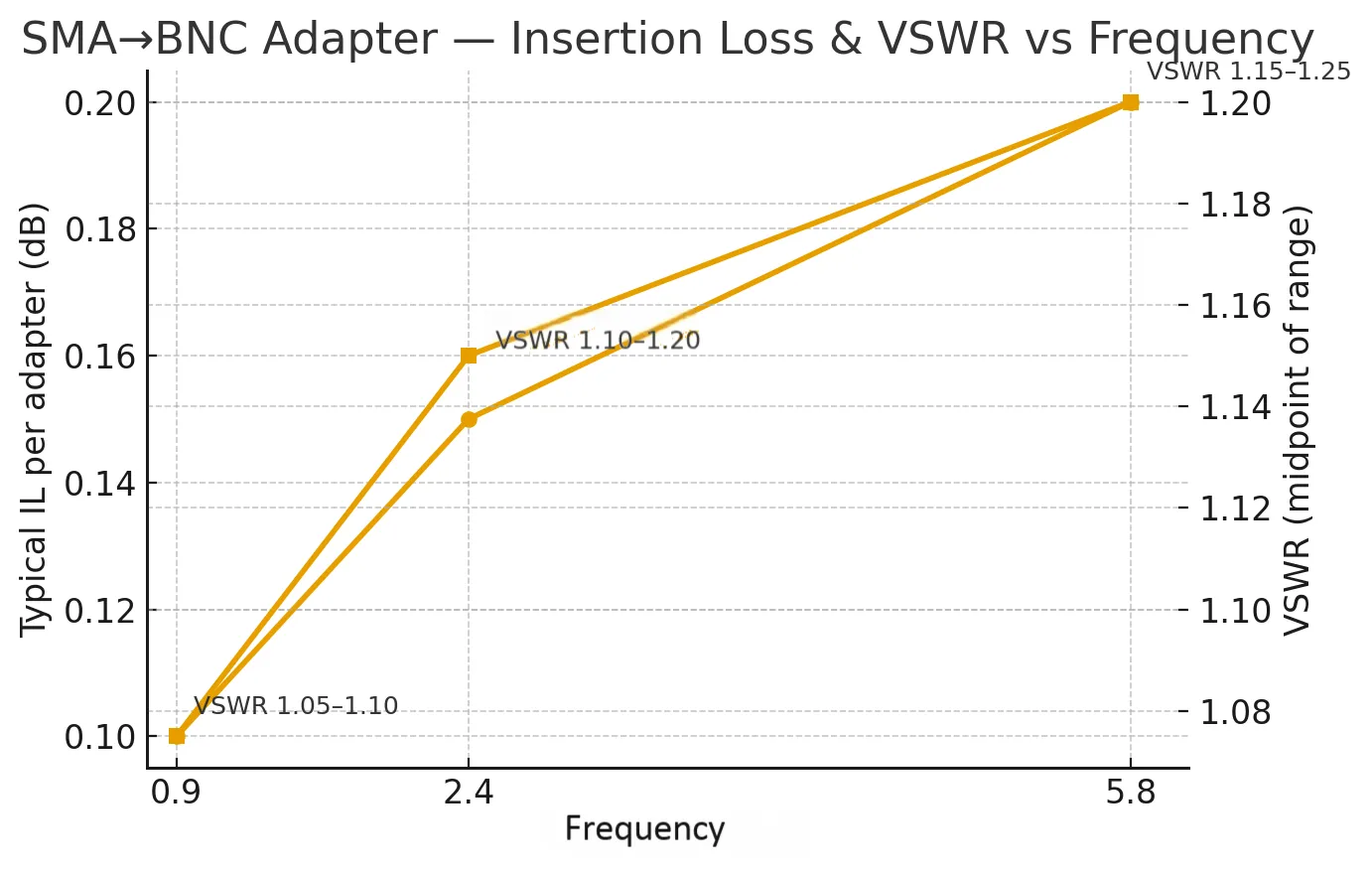
titled "Insertion Loss and VSWR VS Frequency". This chart, based on TEJIATE's in-house testing, visually presents the typical insertion loss and VSWR ranges (e.g., VSWR between 1.10-1.25) for SMA to BNC adapters across different frequencies. It provides users with key data to evaluate the adapter's performance at high frequencies (e.g., Wi-Fi 5.8 GHz).
When to use a short coax jumper instead of a metal coupler
Stacking too many rigid adapters is a recipe for both electrical and mechanical trouble. Once you hit two couplers in a row, it’s smarter to switch to a short coaxial jumper.
A flexible sma extension cable — often RG316 — absorbs mechanical stress and tends to perform better than three rigid couplers chained together. In fact, in lab environments where gear is reconfigured daily, a 20–30 cm jumper becomes almost a permanent fixture. It keeps ports safe and results consistent.
How do I ensure outdoor/motion reliability?
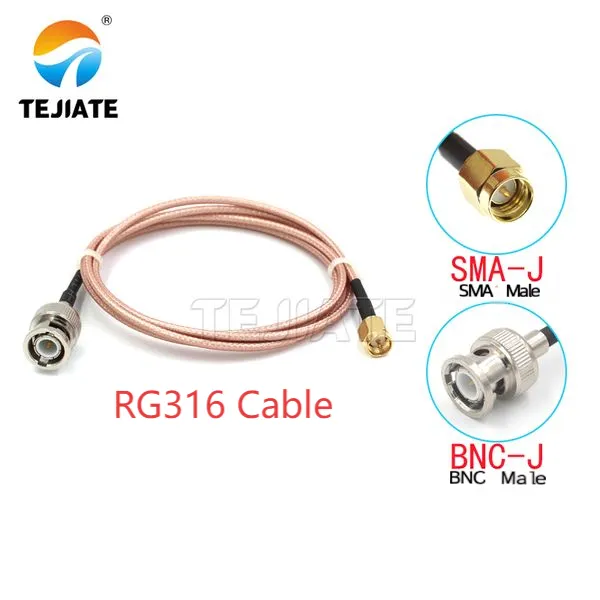
appearing during the discussion of "How do I ensure outdoor/motion reliability?". It illustrates a common solution for improving reliability: using an SMA to BNC adapter in conjunction with a flexible RG316 cable assembly. The document notes that this combination can absorb mechanical stress and vibration, protecting equipment ports, and is particularly suitable for harsh environments like towers, inside vehicles, or on portable gear.
Torque, vibration, bulkhead feed-through
SMA threads are delicate — too loose, and connections drift; too tight, and you risk stripping them. The recommended tightening torque is about 0.45 Nm, which provides enough grip without damaging the threads. For equipment exposed to vibration, a bulkhead SMA to BNC adapter with a locking nut is a safer option. It fixes the connector in place and prevents stress from transferring directly to the PCB or housing.
TEJIATE’s adapters are typically tested for ≥500 mating cycles, so they can survive repeated connections. Still, if your setup involves constant motion, combining the adapter with a short sma jumper cable can absorb shock and protect the ports.
Note from the field: I’ve seen handheld radios mounted in vehicles fail because the adapter was free-floating. Switching to a bulkhead feed-through eliminated vibration issues overnight.
Weather sealing strategies
Outdoor deployments bring a different set of challenges. Even the best-machined coupler won’t last if moisture seeps in. A layered protection plan works best:
- Use O-rings or gasketed bulkhead adapters as the first barrier.
- Add rubber boots or waterproof caps to shield exposed bayonet ends.
- Route the link through a short SMA extension cable, combined with an sma connector for antenna that’s built for outdoor duty. This keeps the rigid adapter safe inside a sealed box, while the antenna-side connector takes on the weather.
I’ve seen rooftop installs where corrosion set in within weeks simply because the adapter itself was left exposed. Swapping to an antenna-rated connector solved the problem and doubled service life. For more field-tested sealing tips, check the SMA antenna extension cable IP67 guide.
Do I need an adapter or an extension/jumper instead?
Decision tips and wiring sketches
- Adapter only to Best for compact setups where low insertion loss is critical.
- Extension cable to Safer when ports are recessed, space is limited, or gear is frequently moved.
A typical chain might look like this: Radio with SMA-M port to SMA male-to-female adapter or sma extension cable to SMA to BNC adapter to Instrument. This layout spreads out the strain, reducing the risk of damaging fragile SMA threads.
Lab vs field deployment
- Lab use: Straight adapters shine here. They minimize additional insertion loss, keeping values around 0.1–0.15 dB up to 6 GHz. If you’re chasing measurement accuracy, fewer pieces in the chain is always better.
- Field use: A short jumper cable is usually worth the trade-off. Flexible RG316 or RG316D jumpers, rated for -40°C to +85°C and tested for ≥500 mating cycles, handle movement and vibration much better than rigid couplers.
For details on how RG316 compares with RG316D, the SMA extension cable guide breaks down bend radius, attenuation, and durability.
What specs should I submit before ordering?
Gender, angle, impedance, band, materials, plating
When specifying an SMA to BNC adapter, confirm the following:
- Gender combination to SMA-M to BNC-F, SMA-F to BNC-M, or other pairings.
- Angle to straight or right-angle.
- Impedance to 50 Ω for most RF work, 75 Ω for broadcast and CCTV.
- Frequency range to TEJIATE’s adapters, for example, are rated DC–18 GHz with insertion loss ≤0.15 dB @ 6 GHz.
- Material to stainless steel for strength, or gold-plated brass for conductivity.
- Dielectric to PTFE, with RoHS compliance for safety and reliability.
Supplying this level of detail shortens lead times and ensures you receive exactly what your application demands. For practical examples of how to match connector specs, the SMA connector selection guide offers a step-by-step breakdown.
QC/traceability docs to request
Beyond specs, professional buyers should also ask for documentation:
- Certificate of Conformance (CoC) to verifies compliance with RoHS and other standards.
- Batch traceability codes to useful for audits and long-term system maintenance.
- Basic RF test results to insertion loss (≤0.15 dB @ 6 GHz), VSWR (≤1.2), and visual inspection reports.
These aren’t just “nice-to-have” papers. They provide assurance that every adapter meets the standards you expect. For industries like telecom, aerospace, or defense, they’re often mandatory.
How do I accept incoming adapters fast?
Visual/mechanical/electrical checklist
| Checkpoint | What to Inspect | Pass/Fail Notes |
|---|---|---|
| Visual | Threads smooth, plating intact | Burrs or peeling = fail |
| Center contact | Pin straight, not recessed or bent | Eccentric pin = reject |
| Markings | Impedance (50/75 Ω), batch code visible | Missing code = caution |
| Quick test | Continuity + insulation with multimeter | Open/short = reject |
Adapters in TEJIATE’s line are tested for ≥500 mating cycles and designed with plating resistant to corrosion, but even good batches can hide defects. For step-by-step inspection methods, the RF connector inspection guide is a solid reference.
Tip from practice: Always check one or two pieces from each bag, even if the supplier is reliable. Catching one faulty lot early prevents deploying dozens of bad parts.
Common defects and fixes
Some issues show up more often than others:
- Loose bayonet collar (BNC) to won’t hold under vibration. Replace immediately.
- Flaking gold or nickel plating to accelerates corrosion and raises contact resistance. Reject.
- Bent or offset pins to risk damaging the mating port. Never try to “bend it back.”
If you spot these signs, set the units aside and request a replacement batch. It’s better to delay deployment by a few days than to risk long-term system instability.
For a practical acceptance routine, checklists like the one in the SMA to BNC adapter series help streamline QA without slowing down operations.
FAQs
Will a right-angle SMA to BNC adapter noticeably increase VSWR at 2.4 GHz?
A single sma right angle adapter introduces only a small amount of loss — usually around 0.15–0.2 dB at 2.4 GHz. For Wi-Fi links or handheld radios, you won’t notice much difference. In a calibration lab, though, even small deviations matter. That’s why engineers there prefer a straight adapter or a short sma jumper cable to keep measurements as clean as possible.
How do I tell RP-SMA from SMA before buying a BNC adapter for Wi-Fi gear?
The trick is to look at the center conductor, not the threads. A standard SMA female has a receptacle, while an RP-SMA female flips the rule and still has a receptacle where you’d expect a pin. Wi-Fi routers often use RP-SMA female on the chassis, which confuses many buyers. If you’re ordering a SMA to BNC adapter, confirm this first. A quick glance saves a return. For visual help, the SMA connector basics guide shows side-by-side comparisons.
Is a single metal adapter or a short SMA-to-BNC jumper better for signal loss?
One adapter is fine in most setups. TEJIATE’s SMA couplers, with PTFE dielectric and precision brass pins, hold insertion loss at ≤0.15 dB up to 6 GHz. But if you start stacking two or three adapters, expect extra loss and stress on the port. That’s when a short sma extension cable — 20–30 cm of RG316 — becomes the smarter choice. It flexes, reduces strain, and performs better than a tower of rigid couplers.
Can I mate a 50-ohm SMA to a 75-ohm BNC input without damaging gear?
Yes, impedance mismatch won’t break your equipment. But it does degrade performance. A 50 ohm SMA cable connected to a 75 Ω BNC video input raises VSWR, reduces gain, and in CCTV systems may create ghosting or noise. For quick tests, it may be tolerable. For permanent installs, always use a properly matched SMA to BNC adapter. More on this is covered in the RF coaxial cable guide.
What gender combination do I need for a handheld radio (HT) with SMA-M?
Most handheld radios come with an SMA-Male connector on top. To connect to a BNC antenna or instrument, you’ll need an SMA-M to BNC-F adapter. TEJIATE’s SMA to BNC adapter series includes both straight and right-angle versions, so you can pick the one that best fits your radio’s layout.
When should I switch to an SMA-to-N path instead of SMA-to-BNC?
Use an SMA to N adapter if you’re working outdoors, handling higher RF power, or operating above 6 GHz where shielding and weather resistance matter more. For rackmount instruments, SMA to BNC adapters remain the everyday choice. The SMA to N adapter guide compares the trade-offs in detail.
What quick acceptance checks confirm a good SMA to BNC adapter on arrival?
A short inspection routine is usually enough. Start with the basics:
- Threads and plating should be smooth, no burrs or peeling.
- The center pin must be straight and not recessed.
- Markings should clearly show impedance (50/75 Ω) and batch codes.
- Use a multimeter for continuity and insulation — open or short readings are a red flag.
If your setup involves antennas, go one step further. Verify that the sma connector for antenna mates cleanly with the adapter and locks without wobble. I’ve seen installers blame “bad signals” on the cable, when the real issue was a loose fit between the antenna connector and the adapter.
Adapters like TEJIATE’s are designed for ≥500 mating cycles and corrosion-resistant plating, but quality control is still vital. For a detailed inspection routine, the RF connector inspection checklist provides a structured step-by-step guide.
Bonfon Office Building, Longgang District, Shenzhen City, Guangdong Province, China

A China-based OEM/ODM RF communications supplier
Table of Contents
Owning your OEM/ODM/Private Label for Electronic Devices andComponents is now easier than ever.
